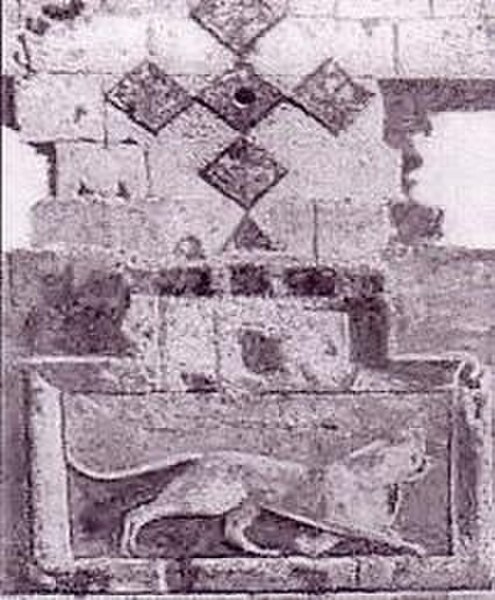The Bagratuni or Bagratid dynasty was an Armenian royal dynasty which ruled the medieval Kingdom of Armenia from c. 885 until 1045. Originating as vassals of the Kingdom of Armenia of antiquity, they rose to become the most prominent Armenian noble family during the period of Arab rule in Armenia, eventually establishing their own independent kingdom. Their domain included regions of Armenia such as Shirak, Bagrevand, Kogovit, Syunik, Lori, Vaspurakan, Vanand and Taron. Many historians, such as Cyril Toumanoff, Nicholas Adontz and Ronald Suny, consider them to be the progenitors of the Georgian royal Bagrationi dynasty.
Bas-relief of a leopard with a cross above it from the ruins of Ani, believed to be a symbol of the Bagratuni dynasty or of Ani.
Smbat II and his brother Kiurike I depicted at the entrance to Haghpat Monastery
The walls of Ani
Armenians are an ethnic group and nation native to the Armenian highlands of West Asia. Armenians constitute the main population of the Republic of Armenia and constituted the main population of the breakaway Republic of Artsakh until the 2023 Azerbaijani offensive in Nagorno-Karabakh and the subsequent flight of Nagorno-Karabakh Armenians. There is a wide-ranging diaspora of around five million people of full or partial Armenian ancestry living outside modern Armenia. The largest Armenian populations today exist in Russia, the United States, France, Georgia, Iran, Germany, Ukraine, Lebanon, Brazil, Argentina, Syria, and Turkey. The present-day Armenian diaspora was formed mainly as a result of the Armenian genocide with the exceptions of Iran, former Soviet states, and parts of the Levant.
Hayk, the legendary founder of the Armenian nation. Painting by Mkrtum Hovnatanian (1779–1846)
The Cathedral of Ani, completed in 1001
Ptolemy, Cosmographia (1467)
Persis, Parthia, Armenia. Rest Fenner, published in 1835.







